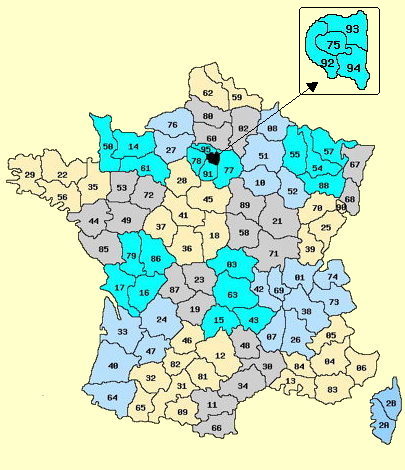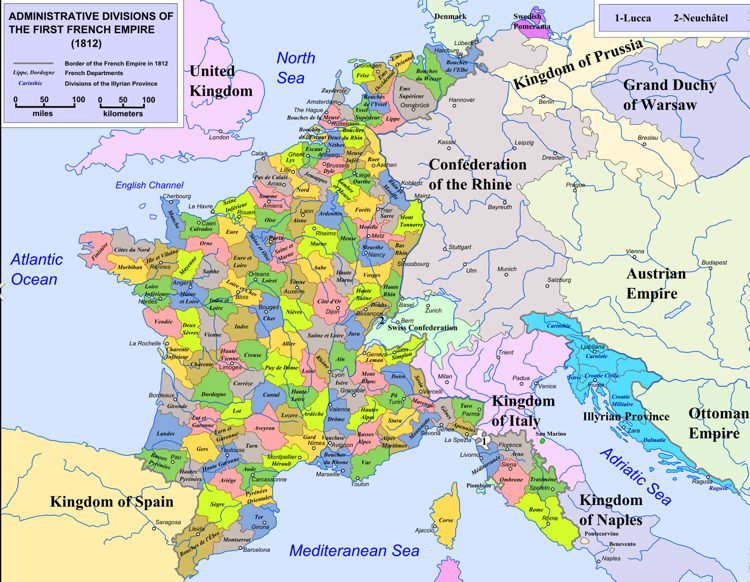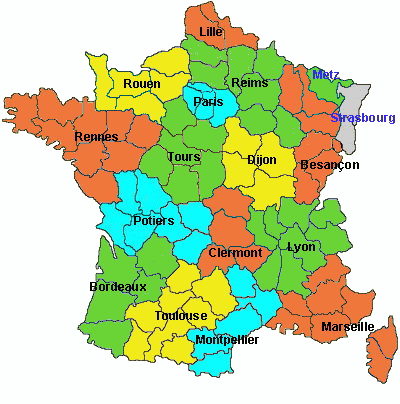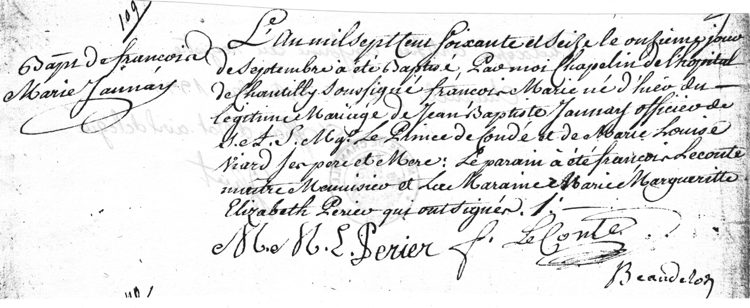France
When seeking information about ancestors, a knowledge of where they lived is paramount to locating records. When researching regions before the start of civil registration this becomes even more significant as the records were generated at the local level. Knowing where the family lived will point you towards the appropriate repositories.
A surprising number of boundaries and borders have changed over the generations and the region the particular place is located in today could be entirely different. This may mean the records sought could be located in unexpected places and therefore a good understanding of borders and boundaries is important.
Apart from boundaries created by civil jurisdictions, a knowledge of the boundaries of ecclesiastical authorities is also significant. This is particularly so in the era prior to the introduction of civil registration when the Established Church maintained what we today would consider a civil function.
Départements in France were created in 1790 to replace the former monarchic regime's province known today as the Ancien Régime
Originally there were 83 départements created 4 March 1790.
The following table represents the current départements.
| France métropolitaine |
|
Département
|
No
|
Administrative town
|
Region
|

|
|
Ain
|
01
|
Bourg-En-Bresse
|
Rhone-Alpes
|
|
Aisne
|
02
|
Laon
|
Picardie
|
|
Allier
|
03
|
Yzeure
|
Auvergne
|
|
Alpes de Haute-Provence
|
04
|
Digne-Les-Bains
|
Provence-Cote d'Azur
|
|
Alpes-Maritimes
|
06
|
Nice
|
Provence-Cote d'Azur
|
|
Ardeche
|
07
|
Privas
|
Rhone-Alpes
|
|
Ardennes
|
08
|
Charleville-Mezieres
|
Champagne
|
|
Ariege
|
09
|
Foix
|
Midi-Pyrenees
|
|
Aube
|
10
|
Troyes
|
Champagne
|
|
Aude
|
11
|
Carcassonne
|
Languedoc-Roussillon
|
|
Aveyron
|
12
|
Rodez
|
Midi-Pyrenees
|
|
Bas-Rhin
|
67
|
Strasbourg
|
Alsace
|
|
Bouches-du-Rhone
|
13
|
Marseille
|
Provence-Cote d'Azur
|
|
Calvados
|
14
|
Caen
|
Basse-Normandie
|
|
Cantal
|
15
|
Aurillac
|
Auvergne
|
|
Charente
|
16
|
Angouleme
|
Poitou-Charentes
|
|
Charente-Maritime
|
17
|
La Rochelle
|
Poitou-Charentes
|
|
Cher
|
18
|
Bourges
|
Centre
|
|
Correze
|
19
|
Tulle
|
Limousin
|
|
Corse-du-Sud
|
2A
|
Ajaccio
|
Corse
|
|
Cote-d'Or
|
21
|
Dijon
|
Bourgogne
|
|
Cote-d'Armor
|
22
|
Saint-Brieuc
|
Bretagne
|
|
Creuse
|
23
|
Gueret
|
Limousin
|
|
Deux-Sevres
|
79
|
Niort
|
Poitou-Charentes
|
|
Dordogne
|
24
|
Perigueux
|
Aquitaine
|
|
Doubs
|
25
|
Besancon
|
Franche-Comte
|
|
Drome
|
26
|
Valence
|
Rhone-Alpes
|
|
Essonne
|
91
|
Corbeil-Essonnes
|
Ile-de-France
|
|
Eure
|
27
|
Evreux
|
Haute-Normandie
|
|
Eure-et-Loir
|
28
|
Chartres
|
Centre
|
|
Finistere
|
29
|
Quimper
|
Bretagne
|
|
Gard
|
30
|
Nimes
|
Languedoc-Roussillon
|
|
Gers
|
32
|
Auch
|
Midi-Pyrenees
|
|
Gironde
|
33
|
Bordeaux
|
Aquitaine
|
|
Haut-Rhin
|
68
|
Colmar
|
Alsace
|
|
Haute-Corse
|
2B
|
Bastia
|
Corse
|
|
Haute-Garonne
|
31
|
Toulouse
|
Midi-Pyrenees
|
|
Haute-Loire
|
43
|
Le Puy-En-Velay
|
Auvergne
|
|
Haute-Marne
|
52
|
Chaumont
|
Champagne
|
|
Haute-Saone
|
70
|
Vesoul
|
Franche-Comte
|
|
Haute-Savoie
|
74
|
Annecy
|
Rhone-Alpes
|
|
Haute-Vienne
|
87
|
Limoges
|
Limousin
|
|
Hautes-Alpes
|
05
|
Gap
|
Provence-Cote d'Azur
|
|
Hautes-Pyrenees
|
65
|
Tarbes
|
Midi-Pyrenees
|
|
Hauts-de-Seine
|
92
|
Nanterre
|
Ile-de-France
|
|
Herault
|
34
|
Montpellier
|
Languedoc-Roussillon
|
|
Ille-et-Vilaine
|
35
|
Rennes
|
Bretagne
|
|
Indre
|
36
|
Chateauroux
|
Centre
|
|
Indre-et-Loire
|
37
|
Tours
|
Centre
|
|
Isere
|
38
|
Grenoble
|
Rhone-Alpes
|
|
Jura
|
39
|
Montmorot
|
Franche-Comte
|
|
Landes
|
40
|
Mont-De-Marsan
|
Aquitaine
|
|
Loir-et-Cher
|
41
|
Blois
|
Centre
|
|
Loire
|
42
|
Saint-Etienne
|
Rhone-Alpes
|
|
Loire-Atlantique
|
44
|
Nantes
|
Pays de la Loire
|
|
Loiret
|
45
|
Orleans
|
Centre
|
|
Lot
|
46
|
Cahors
|
Midi-Pyrenees
|
|
Lot-et-Garonne
|
47
|
Agen
|
Aquitaine
|
|
Lozere
|
48
|
Mende
|
Languedoc-Roussillon
|
|
Maine-et-Loire
|
49
|
Angers
|
Pays de la Loire
|
|
Manche
|
50
|
Saint-Lo
|
Basse-Normandie
|
|
Marne
|
51
|
Chalons-Sur-Marne
|
Champagne
|
|
Mayenne
|
53
|
Laval
|
Pays de la Loire
|
|
Meurthe-et-Moselle
|
54
|
Nancy
|
Lorraine
|
|
Meuse
|
55
|
Bar-Le-Duc
|
Lorraine
|
|
Morbihan
|
56
|
Vannes
|
Bretagne
|
|
Moselle
|
57
|
Metz
|
Lorraine
|
|
Nievre
|
58
|
Nevers
|
Bourgogne
|
|
Nord
|
59
|
Lille
|
Nord
|
|
Oise
|
60
|
Beauvais
|
Picardie
|
|
Orne
|
61
|
Alencon
|
Basse-Normandie
|
|
Pas-de-Calais
|
62
|
Dainville
|
Nord
|
|
Puy-de-Dome
|
63
|
Clermont-Ferrand
|
Auvergne
|
|
Pyrenees-Atlantiques
|
64
|
Pau
|
Aquitaine
|
|
Pyrenees-Orientales
|
66
|
Perpignan
|
Languedoc-Roussillon
|
|
Rhone
|
69
|
Lyon
|
Rhone-Alpes
|
|
Saone-et-Loire
|
71
|
Macon
|
Bourgogne
|
|
Sarthe
|
72
|
Le Mans
|
Pays de la Loire
|
|
Savoie
|
73
|
Chambery
|
Rhone-Alpes
|
|
Paris
|
75
|
Paris
|
Ile-de-France
|
|
Seine-Maritime
|
76
|
Rouen
|
Haute-Normandie
|
|
Seine-et-Marne
|
77
|
Dammarie-Les-Lys
|
Ile-de-France
|
|
Seine-Saint-Denis
|
93
|
Bobigny
|
Ile-de-France
|
|
Somme
|
80
|
Amiens
|
Picardie
|
|
Tarn
|
81
|
Albi
|
Midi-Pyrenees
|
|
Tarn-et-Garonne
|
82
|
Montauban
|
Midi-Pyrenees
|
|
Territoire de Belfort
|
90
|
Belfort
|
Franche-Comte
|
|
Val-de-Marne
|
94
|
Creteil
|
Ile-de-France
|
|
Val-d'Oise
|
95
|
Cergy-Pontoise
|
Ile-de-France
|
|
Var
|
83
|
Saint-Tropez
|
Provence-Cote d'Azur
|
|
Vaucluse
|
84
|
Avignon
|
Provence-Cote d'Azur
|
|
Vendee
|
85
|
La Roche-Sur-Yon
|
Pays de la Loire
|
|
Vienne
|
86
|
Poitiers
|
Poitou-Charentes
|
|
Vosges
|
88
|
Epinal
|
Lorraine
|
|
Yonne
|
89
|
Auxerre
|
Bourgogne
|
|
Yvelines
|
78
|
Versailles
|
Ile-de-France
|
The original 83 départements
The original 83 départements created 4 March 1790 were:
Ain
Aisne
Allier
Ardèche
Ardennes
Ariège
Aube
Aude
Aveyron
Bas-Rhin
Basses-Pyrénées (Pyrénées-Atlantiques from 1969)
Bouches-du-Rhône (lost part to Vaucluse 1793)
Calvados
Cantal
Charente
Charente-Inférieure (gained territory from Dordogne 1794 Charente-Maritime from 1941)
Cher
Corrèze (lost territory to Dordogne 1793)
Corse (split into Golo and Liamone 1793; re-created by merging Golo and Liamone 1811)
Côte-d'Or
Côtes-du-Nord (Côtes-d'Armor from 1990)
Creuse
Deux-Sèvres (border varied 1973 - Puy-Saint-Bonnet to Maine-et-Loire)
Dordogne (In 1793 gained territory from Corrèze< 1793; lost territory to Lot-et-Garonne and Charente-Inférieure 1794; lost territory to Lot 1819)
Doubs (gained Republic of Mandeure in 1793 and permanently in 1816; gained Principality of Montbéliard 1816)
Drôme (annexed Comtat Venaissin 1792 from Papacy; lost territory to Vaucluse 1793)
Eure
Eure-et-Loir
Finistère
Gard
Gers (part lost to Tarn-et-Garonne 1808)
Gironde (Bec-d'Ambès 1793 to 1795)
Haut-Rhin
Haute-Garonne (part lost to Tarn-et-Garonne 1808)
Haute-Loire
Haute-Marne
Hautes-Alpes
Hautes-Pyrénées
Haute-Saône
Haute-Vienne
Hérault
Ille-et-Vilaine
Indre
Indre-et-Loire
Isère (lost territory to Rhône in in 1852 and 1967)
Jura
Landes
Loir-et-Cher
Loire-Inférieure (Loire-Atlantique from 1957)
Loiret
Lot (part lost to Tarn-et-Garonne 1808)
Lot-et-Garonne (gained territory from Dordogne 1794; part lost to Tarn-et-Garonne 1808)
Lozère
Manche
Marne
Mayenne
Mayenne-et-Loire (Maine-et-Loire from 1791; border varied 1973 with Puy-Saint-Bonnet from Deux-Sèvres)
Meurthe (part annexed by Germany and part to Meurthe-et-Moselle September 1871)
Meuse
Morbihan
Moselle (most annexed by Germany and part to Meurthe-et-Moselle September 1871)
Nièvre
Nord
Nord-de-Provence (renamed Haute-Provence and Basses-Alpes March 1790; lost territory to Vaucluse 1793; lost territory to Hautes-Alpes 1810; renamed Alpes-de-Haute-Provence April 1970)
Oise
Orne
Paris (renamed Seine 1795; reverted to Paris and lost bulk of territory January 1968
Pas-de-Calais
Puy-de-Dôme
Pyrénées-Orientales
Rhône-et-Loire (split into Rhône and Loire August 1793)
Saône-et-Loire
Sarthe
Seine-et-Marne
Seine et Oise (broken into Hauts-de-Seine, Seine-Saint-Denis, Val-de-Marne, Val-d'Oise and Yvelines in 1968)
Seine-Inférieure (Seine-Maritime from 1955)
Somme
Tarn
Var
Vendée
Vienne
Vosges
Yonne
Additional départements
1790
Basses-Alpes (created from Nord-de-Provence March 1790)
Haute-Provence (created from Nord-de-Provence March 1790)
1793
Alpes-Maritimes (created 1793; recreated with annexing of Nice 1860; gained part Var 1860; annexed Monarco 1793; gained Italian territory 1947)
Golo – (created by splitting Corse 1793; merged with Liamone to form Corse 1811)
Liamone (created by splitting Corse 1793; merged with Golo to form Corse 1811)
Vaucluse – created from Bouches-du-Rhône, Drôme, and Basses-Alpes August 1793
1808
Tarn-et-Garonne - created from Lot, Haute-Garonne, Lot-et-Garonne, Gers, and Aveyron November 1808
1860
Haute-Savoie – annexed from Kingdom of Sardinia and formalized by treaty 1860
Loire – created by split of Rhône-et-Loire August 1793
Rhône – created by split of Rhône-et-Loire August 1793
Savoie – annexed from Kingdom of Sardinia and formalized by treaty 1860
1871
Meurthe-et-Moselle (created at the end of the Franco-Prussian War from the parts of Moselle and Meurthe which remained French territory 1871)
Moselle – created from lands formerly part of Moselle and Meurthe surrendered to Germany in 1871
Territoire de Belfort – created 1871
1968
Essonne – created from Seine-et-Oise January 1968
Hauts-de-Seine - created from parts of Seine and Seine-et-Oise 1968
Seine-Saint-Denis - created from parts of Seine and Seine-et-Oise 1968
Val-de-Marne - created from Seine-et-Oise in 1968
Val-d'Oise - created from Seine-et-Oise in 1968
Yvelines – created from Seine-et-Oise January 1968
1975
Corse-du-Sud (created 1975 by splitting Corse, territory corresponds to former département of Liamone)
Haute-Corse (created 1975 by splitting Corse, territory corresponds to former département of Golo)
Terrritory gained and lost by conquest
The additional départements gained by conquest and subsequently lost were:
|
Département
|
Captital [English name]
|
Today
|
Predecessor
|
Successor
|
Dates
|
|
Mont-Terrible
|
Porrentruy
|
Switzerland
|
Prince-Bishopric of Basel
|
département Haut-Rhin
|
1793–1800
|
|
Corcyre
|
Corfou [Corfu]
|
Greece
|
Republic of Venice
|
Russia
|
1797–1799
|
|
Ithaque
|
Argostoli
|
1797–1798
|
|
Mer-Égée
|
Zante [Zakynthos]
|
1797–1798
|
|
Dyle
|
Bruxelles [Brussels]
|
Belgium
|
Austrian Netherlands:
• Duchy of Brabant (southern part)
• County of Hainaut
|
Netherlands
|
1795–1814
|
|
Escaut
|
Gand [Ghent]
|
Belgium
Netherlands
|
Austrian Netherlands:
• County of Flanders
Dutch Republic:
• United States of the Zeelandic Flanders
|
1795–1814
|
|
Forêts
|
Luxembourg
|
Luxembourg
Netherlands
|
French Protectorate:
• Duchy of Bouillon
Duchy of Luxembourg
|
1795–1814
|
|
Jemmape
|
Mons
|
Belgium
|
Austrian Netherlands:
• County of Hainaut (most)
• Lordship of the City of Tournai
• County of Namur (part: City of Charleroi)
Bishopric of Liège
|
1795–1814
|
|
Lys
|
Bruges
|
Austrian Netherlands:
• County of Flanders
|
1795–1814
|
|
Meuse-Inférieure
|
Maëstricht [Maastricht]
|
Belgium
Netherlands
|
Austrian Netherlands:
• Austrian Upper Guelders
• Duchy of Limburg (part)
Dutch Republic:
• Dutch Upper Guelders
• Limburg of the States
• Maastricht
Bishopric of Liège:
• County of Horne
• County of Loon
• Imperial Abbey of Thorn
|
1795–1814
|
|
Deux-Nèthes
|
Anvers [Antwerp]
|
Belgium
|
Austrian Netherlands:
• Duchy of Brabant (northern part)
|
1795–1814
|
|
Kingdom of Holland:
• Duchy of Brabant (southern part)
|
1810–1814
|
|
Ourthe
|
Liège
|
Belgium
Germany
France
|
Austrian Netherlands:
• Duchy of Brabant
• Duchy of Limburg
• Duchy of Luxembourg
• County of Namur (part)
Bishopric of Liège (part)
Imperial Abbey of Stavelot-Malmedy
|
1795–1814
|
|
Sambre-et-Meuse
|
Namur
|
Belgium
|
Austrian Netherlands:
• Duchy of Brabant
• Duchy of Luxembourg
• County of Namur (most)
Bishopric of Liège (part)
|
1795–1814
|
|
Mont-Tonnerre
|
Mayence [Mainz]
|
Germany
|
Archbishopric of Mainz
Electoral Palatinate
• Palatinate of the Rhine
• Duchy of Zweibrücken
Bishopric of Speyer
|
Bavaria
Hesse-Darmstadt
|
1798–1814
|
|
Rhin-et-Moselle
|
Coblence [Koblenz]
|
Archbishopric of Cologne
Electoral Palatinate of the Rhine
Archbishopric of Trier
|
Kingdom of Prussia
|
1798–1814
|
|
Roer
|
Aix-la-Chapelle [Aachen]
|
Germany
Netherlands
|
Imperial Free City of Aachen
Archbishopric of Cologne (west of Rhine)
Electoral Palatinate of the Rhine:
• Duchy of Berg
• Duchy of Cleves (west of Rhine)
• Duchy of Jülich
Kingdom of Prussia:
• Duchy of Guelders
|
Netherlands
Prussia
|
1795–1814
|
|
Imperial Free City of Wesel
|
1805–1814
|
|
Sarre
|
Trèves [Trier]
|
Belgium
Germany
|
Electoral Palatinate of the Rhine:
• County of Veldenz
Archbishopric of Trier
|
Kingdom of Prussia (most)
Duchy of Oldenburg
Bavaria
|
1801–1814
|
|
Doire
|
Ivrée [Ivrea]
|
Italy
|
Kingdom of Sardinia
• Duchy of Savoy
• Piedmont
|
Kingdom of Sardina
|
1802–1814
|
|
Marengo
|
Alexandrie [Alessandria]
|
|
Pô
|
Turin
|
|
Sésia
|
Verceil [Vercelli]
|
|
Stura
|
Coni [Cuneo]
|
|
Tanaro
|
Asti
|
1802–1805
|
|
Apennins
|
Chiavari
|
Republic of Genoa
|
1805–1814
|
|
Gênes
|
Gênes [Genoa]
|
|
Montenotte
|
Savone [Savona]
|
|
Arno
|
Florence
|
Grand Duchy of Tuscany
|
Grand Duchy of Tuscany
Duchy of Lucca
|
1808–1814
|
|
Méditerranée
|
Livourne [Livorno]
|
|
Ombrone
|
Sienne [Siena]
|
|
Taro
|
Parme [Parma]
|
Duchy of Parma & Piacenza
|
Duchy of Parma & Piacenza
|
|
Rome (Tibre to 1810)
|
Rome
|
Papal States
|
Papal States
|
1809–1814
|
|
Trasimène
|
Spolète [Spoleto]
|
|
Bouches-du-Rhin
|
Bois-le-Duc ['s-Hertogenbosch]
|
Netherlands
|
Kingdom of Holland:
• Brabant of the States
• Dutch Guelders
|
Netherlands
|
1810–1814
|
|
Bouches-de-l'Escaut
|
Middelbourg [Middelburg]
|
Kingdom of Holland:
• County of Zeeland
|
|
Simplon
|
Sion
|
Switzerland
|
Rhodanic Republic
|
République des Sept Dizains
|
|
Bouches-de-la-Meuse
|
La Haye [The Hague]
|
Netherlands
|
Kingdom of Holland:
• County of Holland
|
Netherlands
|
1811–1814
|
|
Bouches-de-l'Yssel
|
Zwolle
|
Kingdom of Holland:
• Overijssel
Lordship of Steinfurt (to Lippe)
|
|
Ems-Occidental
|
Groningue [Groningen]
|
Netherlands
Germany
|
Kingdom of Holland:
• Dutch Upper Guelders (part)
Electoral Palatinate:
|
|
Ems-Oriental
|
Aurich
|
Germany
|
Kingdom of Holland:
County of East Frisia
|
Kingdom of Hanover
|
|
Frise
|
Leuwarden [Leeuwarden]
|
Netherlands
|
Kingdom of Holland:
• Frisia
|
Netherlands
|
|
Yssel-Supérieur
|
Arnhem
|
Kingdom of Holland:
• Dutch Upper Guelders (part)
• Duchy of Cleves (east of Rhine -arrondissement Rees to Lippe)
Prussia:
• Bishopric of Münster (to Lippe)
|
|
Zuyderzée
|
Amsterdam
|
Kingdom of Holland:
• County of Holland
• Lordship of Utrecht
|
|
Bouches-de-l'Elbe
|
Hamburg
|
German
|
Free Hanseatic City of Hamburg
Electorate of Hanover
Free Hanseatic City of Lübeck
|
Kingdom of Hanover
Duchy of Saxe-Lauenburg
Free City of Hamburg
Free City of Lübeck
|
|
Bouches-du-Weser
|
Brême [Bremen]
|
Free Hanseatic City of Bremen
Electorate of Hanover:
•Duchy of Oldenburg
|
Kingdom of Hanover
Duchy of Oldenburg
Free City of Bremen
|
|
Ems-Supérieur
|
Osnabrück
|
Electorate of Hanover
Bishopric of Osnabrück
Kingdom of Prussia:
• Town and County of Lingen
• Principality of Minden
• County of Ravensberg
|
Kingdom of Hanover
|
|
Lippe
|
Munster
|
arrondissement Munster (from Yssel-Supérieur)
arrondissement Rees (from Yssel-Supérieur)
arrondissement Steinfurt (from Bouches-de-l'Yssel)
arrondissement Neuenhaus (from Ems-Occidental)
Grand Duchy of Berg
|
Kingdom of Hanover
Kingdom of Prussia
|
|
Bouches-de-l'Èbre
|
Lérida [Lleida]
|
Spain
|
Kingdom of Spain:
• Catalonia
|
to département Bouches-de-l'Èbre-Montserrat
|
1812–1813
|
|
Montserrat
|
Barcelone [Barcelona]
|
|
Sègre
|
Puigcerda [Puigcerdà]
|
to département Sègre-Ter
|
|
Ter
|
Gérone [Girona]
|
|
Bouches-de-l'Èbre-Montserrat
|
Barcelone [Barcelona]
|
Previously the départements of Bouches-de-l'Èbre and Montserrat
|
Spain
|
1813–1814
|
|
Sègre-Ter
|
Gérone [Girona]
|
Previously the départements of Sègre and Ter
|

Click to access information about present day locations.
Ecclesiastical authorities
 Apart from boundaries created by civil jurisdictions, a knowledge of the boundaries of ecclesiastical authorities is also significant in family history. This is particularly so in the era prior to the introduction of civil registration when the Established Church maintained what we today would consider a civil function. The current Archdioceses are illustrated with the suffrgan dioceses. There are two exceptions - The Diocese of Metz and the Archdiocese of Strasbourg are subject to the Holy See and not the regional Primate. Unlike England which has a Primate for the whole country, France has a number of Primates where the term aligns more closely to ecclesiastical provinces. Apart from boundaries created by civil jurisdictions, a knowledge of the boundaries of ecclesiastical authorities is also significant in family history. This is particularly so in the era prior to the introduction of civil registration when the Established Church maintained what we today would consider a civil function. The current Archdioceses are illustrated with the suffrgan dioceses. There are two exceptions - The Diocese of Metz and the Archdiocese of Strasbourg are subject to the Holy See and not the regional Primate. Unlike England which has a Primate for the whole country, France has a number of Primates where the term aligns more closely to ecclesiastical provinces.
Most dioceses coincide with a départementales boundary, but there are a few exceptions when some arrondissements are attached to a diocese outside the département, or form a separate diocese within the département especially in densely populated areas. In 1905 the separation of Church and State was recognised in law.
Acessing ecclesiastical records in France is not a major issue as with pre-1837 English research because the records were handed to the state!
Church records become crucial for pre-1792 research since civil authorities did not begin registering vital statistics until 1792. Prior to this church records are often the only sources of family information. Church records continued to be kept after the introduction of civil registration.They areless detailed than the civil registers.
Church registers were handed over to departmental archives or town registrars. You will not find a parish register pre-dating 1792 in a church collection. The departmental archives will answer written inquiries regarding the whereabouts of the parish registers of a specific locality, but they will not search for a name in them.
The current structure as illustrated is modern, dating from 2002.
Where are the records?
The genealogical records you need to trace French ancestors are kept at the Deparemental Archives (Archives Départementales) and in local town halls where they are called Municipal Archives (Archives Municipales).
Some genealogical records have been digitised and made public online. A list of the Departmental Archives websites and what you can expect to find is maintained by Geneanet. You will find most archives have little material available to anyone but personal visitors!
Vital records
In 1539, King Francis I of France ordered the general keeping of baptismal and burial registers. The marriage registers have been introduced in 1579. In 1792, during the French Revolution, the Legislative Assembly has introduced the Civil Registers for the general keeping of birth, marriage and death records.
The Civil Registers are kept at the local town halls and a copy is send to the Departmental Archives after 100 years. The Parish Registers are kept at the Departmental Archives. These are accessed via the Decennial Tables that are a ten-year alphabetical index of all births, marriages and deaths recorded in the Civil Registers. The Decennial Tables are kept at the local town halls and a copy is send to the Departmental Archives after 100 years.
Census returns
The Censuses (Recensements) were held in 1772, 1831, 1836, 1841, 1846, 1851, 1856, 1861, 1866, 1872, 1876, 1881, 1886, 1891, 1896, 1901, 1906, 1911, 1921, 1926, 1931, 1936, 1946, 1954, 1962, 1968 and 1975. The censuses that named individuals rather than just provide a count, les recensements or les dénombrements, began in 1836. Census-taking did not begin in Paris before 1926.
French censuses are seldom used for research because they have not been indexed. However, this is less of a barrier for small localities. Census records less than 100 years old are embargoed and may not be searched. You may find that pre-1887 censuses in the area of your interest have been destroyed in accordance with an 1887 decree, but this law was not applied everywhere. National censuses are usually found in the departmental archives. The early local census records, that were in reality tax records, of a few locations have been published or microfilmed. There are copies of these held by FamilySearch. They are listed in the FamilySearch Catalog in the Place Search under France, [Departément], [Town] - census.
Taxation records
The French Revolution transformed the tax system completely. In 1791 the contributions directes were established. This is a group of three types of taxes:
- Contribution foncière - a land tax
- Contribution mobilière - a buildings tax
- Patente - a tax based on one's profession or business
The impôt sur les portes et fenêtres - a tax on doors and windows - was added in 1798.
These four formed the basis of the French tax system for the next century, until they were replaced by the income tax in 1917.
As a part of this tax collection process, each commune, every city, town and village, was required to make a matrice, or list of taxpayers, their addresses and professions. However, the matrice in many rural areas are little more than a name and the amount due.
Search strategy
To search for genealogical records, you must know in which department your ancestors lived. In the Postal Code the first two digits are representing the department in which the town is located. Many websites can help you find the Postal Code of a town. For example, go to www.codespostaux.com then enter the name of the town in the search form and click the Recherche button. It will give you the Postal Code, the name of the department and the name of the region. You can also search for the name of the town in the French Wikipedia at fr.wikipedia.org.
The 1776 baptism
certificate for François Marie Jaunay held in the Chantilly Archives Municipales…

|